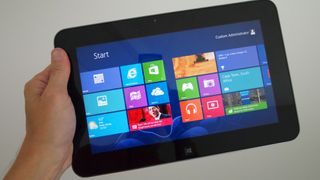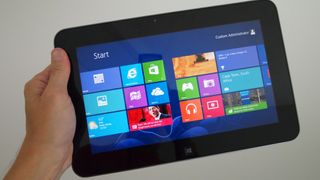Of all the biggest missed opportunities in Microsoft’s rather long history of squandered chances, Windows on Arm is the one I’m saddest about – but that could soon change.
When Windows 10 on Arm was first being touted (the less said about the earlier Windows RT the better), the promise of a fully-fledged version of Windows running on Arm-based hardware usually found in smartphones and tablets (rather than the more common Intel and AMD hardware) was incredibly exciting.
We were told that Windows 10 on Arm would combine the power and flexibility of the best laptops with some of the best features of smartphones and tablets – particularly speedy boot times, fast resume, always-connected internet, and day-long battery life.
Unfortunately, the reality was quite different from those lofty promises. While battery lives of Windows 10 on Arm devices were certainly impressive for the time, performance was poor, especially considering that Windows 10 on Arm devices were also very expensive.
Worst of all, these devices could only run apps downloaded from the Windows Store (now known as the Microsoft Store), and those apps had to have Arm-compatible versions.

Unfortunately, most Windows apps are designed for Intel and AMD hardware (also known as x64 architecture). This makes sense as the vast majority of Windows devices – especially during the Windows 10 years – was built on x64 hardware. So, many app developers didn’t see the point of making Arm-compatible versions, and this meant that not only were Windows 10 on Arm devices more expensive and less powerful than standard Windows 10 laptops, but they also couldn’t run a lot of the most popular applications – a fatal combination.
Poor sales of Windows on Arm devices inevitably followed, and that, in turn, meant app developers were less likely to port their products to Arm.

Breaking the vicious cycle
Unfortunately, the lack of both apps and customers set off a vicious cycle that impacted the success of later Windows 11 on Arm devices.
However, there have been some exciting breakthroughs that could positively affect the fortunes of Windows 11 on Arm devices, and might finally allow them to reach their full potential.
The most important development has been the launch of the Qualcomm Snapdragon X Plus and Elite chips. Qualcomm is one of the biggest companies in the world, and while it might not have the kind of brand recognition that the likes of Intel and AMD have, its Arm-based chips have been powering millions of mobile devices around the world. The company has been a key partner of Microsoft’s when it comes to Windows on Arm devices and has applied its experience of making Arm chips for mobile devices to create more powerful chips for computing devices. While these haven’t always been successful, the latest generation promises some very exciting things.
Qualcomm’s Snapdragon X Elite is the most powerful variant, and it’s shaping up to be an Arm chip that could finally live up to expectations. My colleague, UK Computing Editor Christian Guyton, was particularly impressed when he tested out some prototype laptops earlier this month that were powered by the X Elite. He was able to play Baldur’s Gate 3, a rather complex game, at a decent framerate and resolution.
This struck me as evidence that Qualcomm might have cracked two of the biggest issues with Windows on Arm devices. First, there’s the performance. While Baldur’s Gate 3 on the Snapdragon X Elite-powered device was playable, it won’t trouble the best gaming laptops – but the fact that it even ran at all is impressive. This bodes well for the day-to-day performance of Snapdragon X Elite-powered laptops.
There’s also the important fact that there’s no Arm version of Baldur’s Gate 3 for Windows devices. This means that the game is using emulation to allow it to work on Arm hardware. This comes at a performance cost, which makes the playable state of the game on the Snapdragon X Elite even more impressive. It also shows that even demanding non-Arm applications can be made to work on Arm hardware without needing a native Arm version. This could pave the way for more programs coming to Windows on Arm – and it isn’t dependent on the developers making dedicated versions. This could address the issue of a lack of apps on Windows on Arm.
Alongside the Snapdragon X Elite, Qualcomm also has Snapdragon X Plus, a more affordable chip that lowers the CPU core count (10 cores compared to the Elite’s 12) and lower speed (3.4GHz vs 3.8GHz). If the performance remains competitive (and early benchmark leaks suggest that it does), and the price is low enough, we could see Windows on Arm devices that aren’t overpriced and offer much better value for money – addressing yet another common criticism of Windows on Arm devices.

The Apple effect
Before the launch of the Snapdragon X series, Windows on Arm was in a bad place. Things looked particularly grim as Microsoft’s old rival, Apple, was enjoying huge success and critical acclaim with its lineup of Macs powered by its M1 (and later M2 and M3) chips – which are built on Arm architecture.
While Windows on Arm struggled, the MacBook Air (M1, 2020) and co were proving that Arm-powered laptops weren’t just viable, they could be the future of computing. Offering the long battery lives and quick startups we’d been promised, Apple’s first generation of Mac and MacBooks that ran on the company’s Arm-based chips, rather than the Intel hardware of older models, were a hit. And, while the MacBook Air’s launch price of $999 / £999 / AU$1,599 wasn’t exactly cheap, it was a competitive price point. And with the M1 providing an excellent level of performance, the high price tag is far more justified.
The best thing about the M1 Apple Macs was a tool by Apple called Rosetta 2. This was an emulation layer that allowed almost all existing Mac apps to run on the new M1 hardware. This meant Mac users switching to an M1 device would be able to use pretty much all of their important apps and programs, even if M1 native apps were thin on the ground.
This was a canny move by Apple, as it meant that M1 products were a big success, and because of that, app developers started making versions of their products that could run on M1 hardware without the need for emulation – and could take full advantage of Apple’s chip.
When the M2 series of Macs and MacBooks came out, Rosetta 2 was still in use – but the number of times I’ve had to use it when using an M2 MacBook dropped significantly, as there was a growing library of M2 apps.
By the time the M3 chips rolled around late last year, the number of times I (and other users) had to rely on Rosetta 2 was even rarer. Very few bits of software can be considered a success if fewer people need to use it, but that’s exactly what happened here. Rosetta 2 allowed Mac owners to switch to Arm-based Macs with ease, while also giving app developers the time to develop native apps. And the more people that switched to Arm Macs, the more attractive it became for app developers to port their apps to the platform.

It’s now up to Microsoft
So, Apple proved that Arm-based laptops can be successful, and Qualcomm looks like it could have addressed many of the hardware issues. Does this mean the next generation of Windows on Arm devices will be a slam dunk?
Sadly, that’s not a guarantee just yet as there’s one company that needs to pull its weight to give Windows on Arm devices their best chance of success: Microsoft.
While it’s obvious that Microsoft would want Windows on Arm to succeed, the way it’s handled previous generations has been frustrating. The fact that there’s never been a tool similar to Rosetta 2 that would make running non-Arm apps run easily is particularly annoying.
Now, I’m sure this is due to it being a very complex job. After all, Windows devices are made by various manufacturers that use components from different companies, which leads to a potentially limitless range of Windows PC configurations. Macs, on the other hand, have much more limited configurations, with the hardware mainly being built by Apple.
However, the lack of apps is perhaps the biggest hurdle still standing for Windows on Arm, especially when there are Macs out there that can run a much wider range of apps. And, this is a problem that should be in Microsoft’s powers to do something about.
Microsoft does have tools for getting non-Arm software running on Arm hardware using emulation, but it hasn’t taken off in the same way, mainly because it’s not as easy to use and doesn’t work quite as well, with some apps still refusing to run.
If Microsoft can’t come up with a Rosetta 2-beating solution, then it needs to do more work convincing app developers to port their software to Arm. This might be a difficult feat, especially when the user base is so low, but Microsoft is a very successful company with plenty of resources. It could provide financial incentives, or offer developers and tools to help port the biggest apps.
Microsoft is also a hardware company, and its past attempts to create Windows on Arm devices suffered from the problems that have become all too familiar. The Surface Pro X, for example, came with Microsoft’s SQ1 Arm-based chip, made in conjunction with Qualcomm. It was also overpriced and didn’t perform well.
However, rumors are swirling that Microsoft could be releasing Surface Pro and Surface Laptop devices soon that will feature Snapdragon X chips. If Microsoft can nail both the software and hardware sides, we could see a new era of Windows on Arm devices that are actually worth buying. And Microsoft could give Apple’s rumored M4-powered Macs a run for their money.
However, if these devices come out with unappealing price tags, poor performance, and a continued lack of app support, then it could be the end of the Windows on Arm dream. After all, if Microsoft itself can’t make a success of it, what hope do other companies have?
You might also like
Services Marketplace – Listings, Bookings & Reviews
